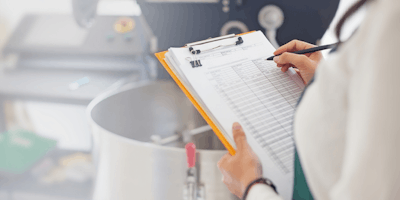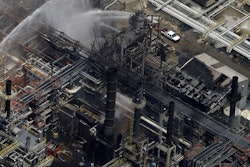
RSM
4. BUILDING PROCESS MAPS
Documentation should include both
building and facility maps, as well as
process flow maps for food processing.
5. INVENTORY MANAGEMENT
Maintain accurate documentation on how
ingredients enter your facility and the
location of all finished goods.
+1 800 274 3978
www.rsmus.com
RSM US LLP is the U.S. member firm of RSM International, a global network of independent audit, tax, and consulting firms. Visit rsmus.com/aboutus for more information regarding RSM US LLP and RSM International.
© 2016 RSM US LLP. All Rights Reserved. ig-nt-tmc-cp-0616
REFERENCES
1 "Food Safety Preventive Control Plan Checklist," Iowa State University Extension and Outreach, Iowa Grain Quality Initiative, Department of Food Science and Human Nutrition, V. 2.1; Jan. 3, 2013.
2 "FDA Food Safety Modernization Act (FSMA)," U.S. Food and Drug Administration. Last updated Sept. 17, 2013. Accessed Sept. 25, 2013 via
http://www.fda.gov/Food/GuidanceRegulation/fSMA/default.htm
CONTACT JOHN MAJEWSKI AT [email protected]
COMPLIMENTARY ONE-HOUR SYSTEM REVIEW:
LEARN IF AND HOW YOUR CURRENT INFRASTRUCTURE SUPPORTS FSMA REQUIREMENTS.
6. RECALL ACTION
Develop and implement a written recall
action plan outlining procedures to follow
for product tracing after distribution.
7. VENDOR MANAGEMENT
AND APPROVAL
Create a checklist for vendor approval
and ensure the list is maintained.
Key considerations should include the
implementation of safe food handling
practices and the level of risk posed by
each vendor. Similarly, develop cleanliness
measures to test against each vendor's
transportation vehicle.
12. PEST PREVENTION
Develop an established pest-control
program to include periodic inspections,
building adjustments to ensure pests
do not enter facility and written records
provided by pest-control personnel.
13. BIOSECURITY
Your plan should include procedures to
ensure against intentional contamination
of food products. Such procedures may
include measures to control employee
building access after hours, passwords
and locks on computer systems,
employee background checks,
and vehicle transportation control.
8. MEASURABLE TESTS
Your organization should have in place
detailed, documented tests to be
performed on finished food goods to
ensure against chemical and biological
hazards. Tests should be measurable.
9. CONTAMINATION AVOIDANCE
Develop written procedures for cleaning
out containers and storage bins to ensure
against cross contamination. Store all bulk
materials in a manner that prevents
contamination. Ensure all container labels
are waterproof and environment-proof.
10. EMPLOYEE CONDUCT
Safety documentation should include
written policies on employee conduct
and dress code, as well as procedures
to follow concerning restrictions on
employee work (i.e., regulations against
eating, drinking or smoking while around
food products or after contamination
with infectious disease). Ensure all
employees are trained on proper
food conduct in accordance with the
approved safety plan.
11. EQUIPMENT AND FACILITY
CLEANLINESS
Document cleaning procedures for
both equipment and facilities. Sanitation
processes may include scheduled clean-ups,
a spill handling policy, hand-washing practices,
and sewage and septic system inspections.
WHAT YOU NEED TO KNOW
ABOUT FSMA
FSMA: WHAT AREAS DOES IT COVER?
The Food Safety Modernization Act (FSMA), signed into law on Jan. 4, 2011, is focused on preventing, rather than
responding to, contamination in the U.S. food supply. The act is divided into five key sectors, including prevention,
inspection and compliance, response, imports, and enhanced partnerships. Each sector is further divided into
subsections of best practices, covering all aspects of food safety management, as detailed below:
5. ENHANCED PARTNERSHIPS
• State and local capacity building
• Foreign capacity building
• Reliance on inspections by
other agencies
1. PREVENTION
• Mandatory preventive controls for
food facilities
• Mandatory produce safety standards
• Authority to prevent
intentional contamination
2. INSPECTION AND
COMPLIANCE
• Mandated inspection frequency
• Records access
• Testing by accredited laboratories
3. RESPONSE
• Mandatory recall
• Expanded administrative detention
• Suspension of registration
• Enhanced product tracing abilities
• Additional recordkeeping for high-
risk foods
4. IMPORTS
• Importer accountability
• Third-party certification
• Certification for high-risk foods
• Voluntary qualified importer program
• Authority to deny entry
FSMA: WHAT YOU’RE RESPONSIBLE FOR
While the act covers a multitude of areas concerning food safety, many regulations center primarily on prevention,
chiefly the development of specific safety materials required for food facilities. Below are some chief areas of concern
when developing your organization’s food safety documentation:
FOOD AND BEVERAGE
1. SPECIFIED LOCATION
The FSMA requires the development of a written food safety plan that details your company's procedures for:
• Evaluating food safety hazards
• Implementing preventive controls that will minimize or prevent hazards
• Monitoring these controls to ensure their effectiveness
• Maintaining routine monitoring records
• Performing corrective action to address issues that arise
• Identifying critical hazards and documenting how such hazards are controlled within your facility
• Responding to chemical, physical or biological hazards
• Physically separating incoming and outgoing food products
• Responding to and mitigating consumer complaints
3. SPECIFIED LOCATION
Your plan should be in an easily retrievable
location, preferably in both a hard copy
(physical location) and soft copy (network)
format. The hard copy location should be
waterproof, and all copies should be easily
searchable.
2. MANAGEMENT
IMPLEMENTATION
Ensure you have management involvement
in your food safety plan. This may be an
individual or a team, depending on the
size of your operation.






















